The Late Series coinage
by Cori Sedwick Downing
Juan Gutiérrez (Assayer G), 1542-1543
The major design change from Early Series to Late Series took place under the tenure of Assayer G, and all denominations (¼, ½, 1, 2, and 4 reales) were minted in silver. Copper maravedís were minted as well. Additional distinguishing stylistic changes from this point forward can be found in the crowns, castles, and lions (some have tongues again) on the shield side and in the tops of the pillars on the other side. The spelling of the king’s name changed from the Early Series spelling of KAROLVS to CHAROLVS (under Assayer G only), but was soon shortened to CAROLVS (Assayer G forward). Assayer G generally used one or two annulets for stops in the legends, and the oneannulet convention held for 1-real coins made under all subsequent assayers. The use of a trefoil as a stop was an exclusively Assayer-G feature. The use of oM for the mintmark was also an Assayer-G invention, although it was not the only type of mintmark used. Assayer G’s tenure was briefly interrupted by Assayer R, Francisco del Rincón or his brother Alonso del Rincón, in 1543. After that, Assayer G continued until 1545. His tenure produced the best-quality coins of the Late Series, characterized by full legends, round planchets, and deep strikes. It has been suggested that such high quality can be attributed to the anticipated arrival of Francisco Tello de Sandoval, a Spanish investigator who came to the Mexico City mint in May of 1545 to assess accusations of fraud. The so-called Sandoval investigation lasted several months, and perhaps Assayer G was simply putting his best foot forward by taking extra care with minting practices at that time.
Main types with CHAROLVS in the legend:
• oMo-oGo (½ real unknown to Nesmith)
• oM-oG (½ , 2, and 4 reales unknown to Nesmith but at least the 4 reales exist, perhaps all from the “Golden Fleece wreck”)
• oM-G
• M-G
Main types with CAROLVS in the legend:
• G-oM (1 and 4 reales unknown to Nesmith but at least the 4 reales exist, perhaps all from the “Golden Fleece wreck”)
• oM-G
• M-G
• G-M
• oM-oG
• M-G (upside-down)
Oddball coins
The following are some oddball coins that are extremely rare:
IMDIARVM on late Assayer G 4 reales
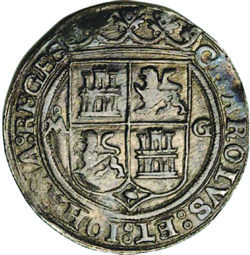
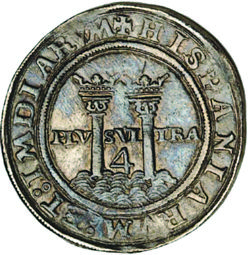
IMDIARVM on Late Series Assayer G 4 reales
(Ponterio auction #150, Aug 2009, 9150)
Inverted G on late Assayer G 1 real and 2 reales
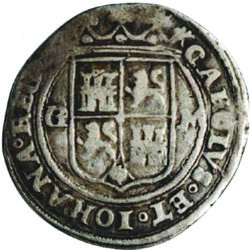
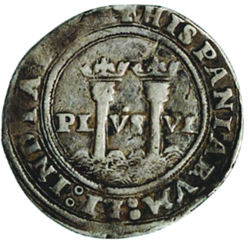
Inverted G on Late Series Assayer G 1 reales
(Ponterio auction #150, lot 9112)
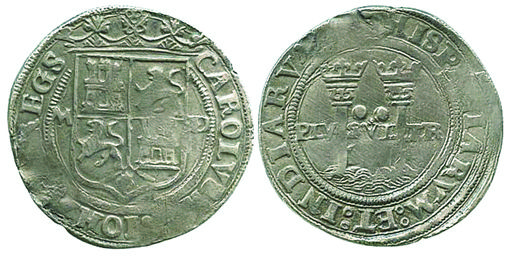 Inverted G on Late Series Assayer G 2 reales
Inverted G on Late Series Assayer G 2 reales
(Sedwick auction #13, Aug 2009 May 2013, lot 937)
Alonso del Rincón (Assayer R), 1543
No ¼- or ½-real coins are known from Assayer R’s tenure, but 1, 2, and 4 reales were struck. Francisco del Rincón, the first assayer of the mint in 1536, swindled his way into buying the assayer’s office out from under Juan Gutiérrez, but Rincón’s brother Alonso most likely ran the mint until Gutiérrez was reinstated. Francisco had previously returned to Spain while Alonso remained in Mexico. The mintmark for Mexico City appeared as an M, and these coins are understandably rare.
Main types:
• M-R (4 reales unknown to Nesmith but exist, perhaps all from the “Golden Fleece wreck”)
• R-M
Oddball coins
The following are some oddball coins that are extremely rare:
Missing mintmark on late Assayer R 4 reales
 Missing Mintmark and Assayer on Late Series Assayer R 4 reales
Missing Mintmark and Assayer on Late Series Assayer R 4 reales
(Sedwick auction #4, Nov 2008. lot 204)
Juan Gutiérrez (Assayer G), 1544-1546?
This second tenure of Assayer G started with coins showing the G assayer-mark punched over an R. It is likely that the best-struck coins of Assayer G were minted in 1545, before and during the investigation by Tello de Sandoval. Otherwise G coins of this period are indistinguishable from G coins of the previous period.
Alonso de Villaseca? (Assayer A), 1546?-1547?
No ¼-real coins are known, but ½, 1, 2, and 4 reales were minted. While Alonso de Villaseca is the name usually attributed to Assayer A, it is by no means certain that this is a correct assumption. These coins are scarce due to the short tenure of Assayer A’s term. The overassayer A/G is known and points to the re-use of dies from Assayer G’s tenure. Most, if not all 4 reales M-A coins are from shipwrecks.
Main types:
• M-A/G
• M-A (½ real unknown to Nesmith but examples exist)
• A-M (1 real unknown to Nesmith but examples exist)
• oM-A (2 and 4 reales unknown to Nesmith and may not exist)
Luis Rodríguez (Assayer L), 1547?-1553?
No ¼-real coins are known from this assayer, but ½, 1, 2, and 4 reales were minted. Coins of Assayer L recovered from the Spanish 1554 Fleet off Padre Island, Texas, bear a mintmark of M. Later in his tenure (presumably after Assayer O began, see below), the coins carried a mintmark of oM and were struck on smaller planchets, often not completely round. The output from this assayer was prolific.
Main types:
• M-L/R
• M-L/A
• L/A-M
• M-L
• L-M
• oM-L
• L-oM
Rodrigo Gómez de Santillán (Assayer S), 1553?-1554?
A single ¼ real is known from this assayer. No ½-real coins are known. Pieces of 1, 2, and 4 reales were struck. Due to his short tenure in office, not many coins were minted, so all are rare. While Gómez de Santillán is usually the name associated with Assayer S, it is not certain he is the correct candidate. Santillán’s actual documented tenure was a decade earlier, late 1543 to early 1544, while the office of assayer was being transferred back to Gutiérrez (Assayer G) and his trustee Villaseca (Assayer A) from Alonso del Rincón (Assayer R). Die details indicate that coins of Assayer S fit between the two tenures of Assayer L and must have been made around 1553-1554, since Assayer-S
coins were recovered from the Spanish 1554 Fleet (Padre Island) but not from the ca.-1550 “Golden Fleece wreck,” which yielded many specimens of the other assayers of the time (G, R, A, and L).
Main types:
• M-S
• oM-S
• S-M (unknown to Nesmith, but at least the 1 real exists)
• S/L-M (unknown to Nesmith, but at least the 4 reales exists)
Oddball coins
The following are some oddball coins that are extremely rare:
V over inverted V in HISPANIARVM on Assayer S 4 reales
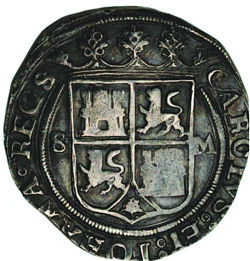
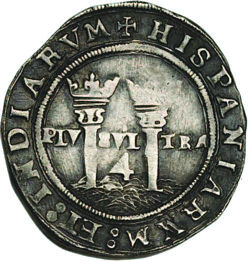
V over Inverted V in HISPANIARVM on Late Series Assayer S 4 reales
(Ponterio auction #150, Aug 2009, lot 9164)
Luis Rodríguez (Assayer L), 1554?-1569
No ¼-real coins are known for Assayer L, but ½, 1, 2, and 4 reales were minted. This is the same assayer as Assayer L above. The mintmark of this period is M or oM. A cruder style of engraving on planchets of varying thickness and roundness distinguishes these coins from Assayer L’s earlier emissions. Two years before his death in 1569, having lived in Mexico for some 40 years, Rodríguez submitted a petition (which was approved in the same year) to transfer his office to his son, Cristóbal Rodríguez of Spain, who leased the office to Assayer O, Bernardo de Oñate. Production at the Mexico City mint at this time was prodigious, so coins of Assayer L are less rare than other assayers and it is obvious that emphasis was on quantity rather than quality.
Main types:
• M-L/S
• L/O-oM
• oM-L/O
• oM-L
• L-oM
Bernardo de Oñate (Assayer O), mid-1550s?-1571?
No ¼-real coins are known for Assayer O; however, ½, 1, 2, and 4 reales were minted. This assayer may have worked under the previous assayer, Luis Rodríguez, or concurrently while that assayer’s health declined, but not before 1554, since no Assayer-O coins were found on the Spanish 1554 Fleet (Padre Island). As stated above, Assayer L transferred his office to his son in 1569, and his son leased that office to Assayer O in the same year, but the presence of Assayer-O coins on the “Ines de Soto wreck” (ca. 1557) proves that at least some Assayer-O coins were struck well before the transfer. The quality of coinage from Assayer O was at an all-time low for the Charles-Joanna issues. Again, quantity over quality was the objective at the mint by this point.
Main types:
• O/L-oM
• O/M-M
• M-O/L
• oM-O/L
• M-O
• O-M (½ and 4 reales were unknown to Nesmith)
• oM-O
• O-oM
Discoveries Since NesmithRobert I. Nesmith, The Coinage of the First Mint of the Americas at Mexico City, 1536-1572 (New York: The American Numismatic Society, 1955), 49-50 (available in the USMexNA online library)
1. Nesmith didn’t know of any ¼-real coins but examples minted under Assayers G and A do exist.
2. While 4 reales M-R coins were unknown to Nesmith and have been considered much more rare than R-M, coins salvaged from the “Golden Fleece wreck” show that both types were minted in almost equal amounts.
3. There were many more varieties of coins struck than Nesmith knew, with differences due to various combinations of obverse and reverse designs coupled with obverse and reverse legends.
4. The correct order of assayers is G, R, G, A, L, S, L, O
